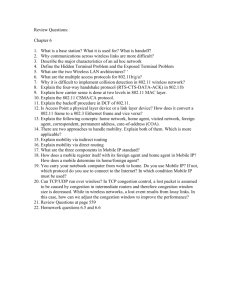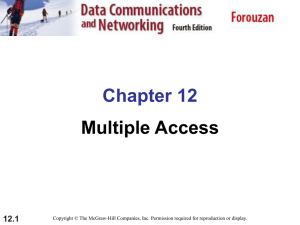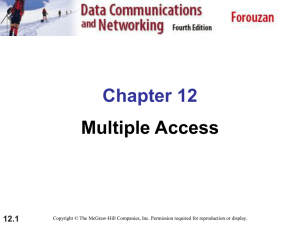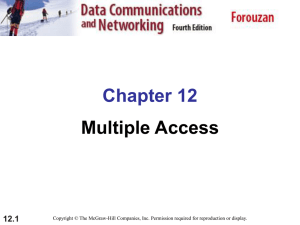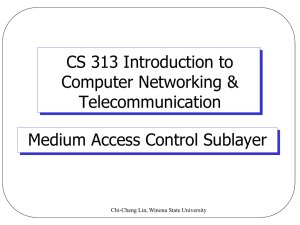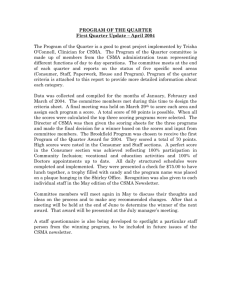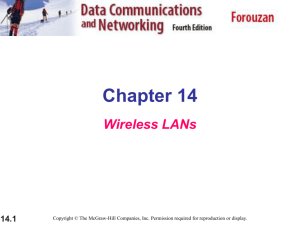Service-Martingales: Theory and Applications to the Felix Poloczek Florin Ciucu
advertisement
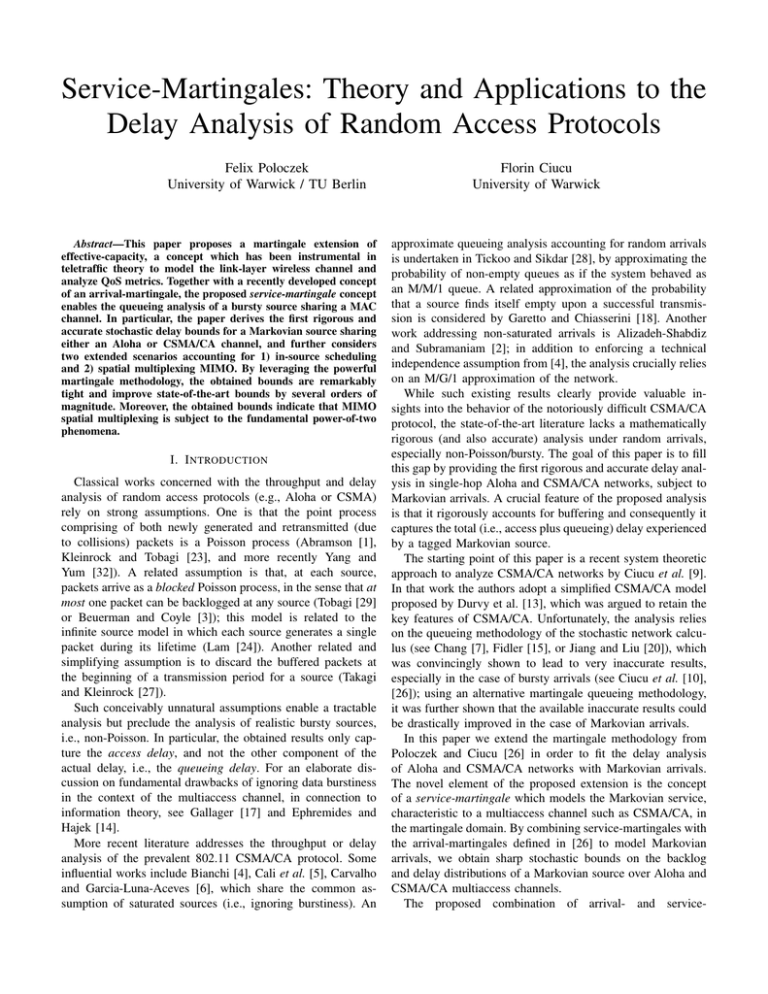
Service-Martingales: Theory and Applications to the
Delay Analysis of Random Access Protocols
Felix Poloczek
University of Warwick / TU Berlin
Abstract—This paper proposes a martingale extension of
effective-capacity, a concept which has been instrumental in
teletraffic theory to model the link-layer wireless channel and
analyze QoS metrics. Together with a recently developed concept
of an arrival-martingale, the proposed service-martingale concept
enables the queueing analysis of a bursty source sharing a MAC
channel. In particular, the paper derives the first rigorous and
accurate stochastic delay bounds for a Markovian source sharing
either an Aloha or CSMA/CA channel, and further considers
two extended scenarios accounting for 1) in-source scheduling
and 2) spatial multiplexing MIMO. By leveraging the powerful
martingale methodology, the obtained bounds are remarkably
tight and improve state-of-the-art bounds by several orders of
magnitude. Moreover, the obtained bounds indicate that MIMO
spatial multiplexing is subject to the fundamental power-of-two
phenomena.
I. I NTRODUCTION
Classical works concerned with the throughput and delay
analysis of random access protocols (e.g., Aloha or CSMA)
rely on strong assumptions. One is that the point process
comprising of both newly generated and retransmitted (due
to collisions) packets is a Poisson process (Abramson [1],
Kleinrock and Tobagi [23], and more recently Yang and
Yum [32]). A related assumption is that, at each source,
packets arrive as a blocked Poisson process, in the sense that at
most one packet can be backlogged at any source (Tobagi [29]
or Beuerman and Coyle [3]); this model is related to the
infinite source model in which each source generates a single
packet during its lifetime (Lam [24]). Another related and
simplifying assumption is to discard the buffered packets at
the beginning of a transmission period for a source (Takagi
and Kleinrock [27]).
Such conceivably unnatural assumptions enable a tractable
analysis but preclude the analysis of realistic bursty sources,
i.e., non-Poisson. In particular, the obtained results only capture the access delay, and not the other component of the
actual delay, i.e., the queueing delay. For an elaborate discussion on fundamental drawbacks of ignoring data burstiness
in the context of the multiaccess channel, in connection to
information theory, see Gallager [17] and Ephremides and
Hajek [14].
More recent literature addresses the throughput or delay
analysis of the prevalent 802.11 CSMA/CA protocol. Some
influential works include Bianchi [4], Cali et al. [5], Carvalho
and Garcia-Luna-Aceves [6], which share the common assumption of saturated sources (i.e., ignoring burstiness). An
Florin Ciucu
University of Warwick
approximate queueing analysis accounting for random arrivals
is undertaken in Tickoo and Sikdar [28], by approximating the
probability of non-empty queues as if the system behaved as
an M/M/1 queue. A related approximation of the probability
that a source finds itself empty upon a successful transmission is considered by Garetto and Chiasserini [18]. Another
work addressing non-saturated arrivals is Alizadeh-Shabdiz
and Subramaniam [2]; in addition to enforcing a technical
independence assumption from [4], the analysis crucially relies
on an M/G/1 approximation of the network.
While such existing results clearly provide valuable insights into the behavior of the notoriously difficult CSMA/CA
protocol, the state-of-the-art literature lacks a mathematically
rigorous (and also accurate) analysis under random arrivals,
especially non-Poisson/bursty. The goal of this paper is to fill
this gap by providing the first rigorous and accurate delay analysis in single-hop Aloha and CSMA/CA networks, subject to
Markovian arrivals. A crucial feature of the proposed analysis
is that it rigorously accounts for buffering and consequently it
captures the total (i.e., access plus queueing) delay experienced
by a tagged Markovian source.
The starting point of this paper is a recent system theoretic
approach to analyze CSMA/CA networks by Ciucu et al. [9].
In that work the authors adopt a simplified CSMA/CA model
proposed by Durvy et al. [13], which was argued to retain the
key features of CSMA/CA. Unfortunately, the analysis relies
on the queueing methodology of the stochastic network calculus (see Chang [7], Fidler [15], or Jiang and Liu [20]), which
was convincingly shown to lead to very inaccurate results,
especially in the case of bursty arrivals (see Ciucu et al. [10],
[26]); using an alternative martingale queueing methodology,
it was further shown that the available inaccurate results could
be drastically improved in the case of Markovian arrivals.
In this paper we extend the martingale methodology from
Poloczek and Ciucu [26] in order to fit the delay analysis
of Aloha and CSMA/CA networks with Markovian arrivals.
The novel element of the proposed extension is the concept
of a service-martingale which models the Markovian service,
characteristic to a multiaccess channel such as CSMA/CA, in
the martingale domain. By combining service-martingales with
the arrival-martingales defined in [26] to model Markovian
arrivals, we obtain sharp stochastic bounds on the backlog
and delay distributions of a Markovian source over Aloha and
CSMA/CA multiaccess channels.
The proposed combination of arrival- and service-
martingales parallels the combination of effective bandwidth
and effective capacity, which provides an elegant methodology
to analyze the queueing behavior in wireless networks. The
effective bandwidth is an arrival model, defined in terms of moment generating functions, and which is particularly suitable
to analyze queues with Markovian and long range dependent
arrivals (see Kelly [22]). In turn, the effective capacity is an
ingenious service model defined in terms of Laplace transforms, and which is particularly suitable to model the channel
capacity in wireless scenarios (see Wu and Negi [30], [31]).
Alike the conventional network calculus, the elegant queueing
methodology based on effective bandwidth/capacity suffers in
terms of the accuracy of the produced queueing results; this
drawback was convincingly illustrated through simulations by
Choudhury et al. [8] and analytically by Ciucu et al. [10],
[26] (e.g., existing bounds can be loose by several orders of
magnitude, in the case of Markovian arrivals).
A key benefit of our proposed methodology integrating
arrival- and service-martingales is its modularity: Indeed,
we provide three conceivably straightforward applications to
both simple and complex MAC scenarios. The first (simple)
scenario is standard and involves the analysis of a tagged
bursty source sharing a MAC channel. We then consider two
complex extensions by additionally accounting for 1) in-source
scheduling, i.e., the tagged source consists of multiple flows
scheduled according to a SP (Static Priority) policy before
being transmitted over the shared channel, and 2) spatial
multiplexing MIMO (multiple-input multiple-output), i.e., the
tagged source is transmitted over multiple shared MAC channels. A qualitative insight of the obtained stochastic bounds is
that MIMO reduces the delays of bursty sources exponentially
(in the number of channels), and, more interestingly, that it is
subject to a fundamental power-of-two phenomena.
The rest of the paper is organized as follows. In Section II
we introduce the concept of service-martingales, and derive
general performance metrics (backlog and delay) for a source
modelled by arrival-martingales. In Section III we apply
these results to a Markovian tagged source transmitting over
Aloha and CSMA/CA channels; numerical results illustrate
the remarkable tightness of the obtained stochastic bounds.
In Section IV we provide further applications to scenarios
with in-source SP scheduling and spatial multiplexing MIMO.
Finally, we conclude the paper in Section V.
II. T HEORY
Consider the single server scenario from Figure 1. A flow
A, defined in terms of the bivariate arrival process
A(m, n) =
n
X
A
S
D
Fig. 1. A server with an arrival process A, service process S, and departure
process D
independent. The reversibility assumption is mild, in the sense
that Markov processes (i.e., the type of bursty sources we are
interested in) can be a-priorily reversed; the concrete Markov
processes from this paper are however reversible. For brevity
we write X(n) := X(0, n) for any bivariate process X.
The key role of the service process S is to model the service
received by A in either a queueing system, or at the data
link layer corresponding to some MAC protocol (e.g., Aloha
or CSMA/CA); the second case particularly suits this paper.
Formally, S couples the arrival and departure processes A and
D, respectively, in terms of a (min, +) convolution, i.e.,
D(n) ≥ A ∗ S(n) := min {A(m) + S(m, n)} ,
0≤m≤n
(1)
for all arrival processes A and n ≥ 0. In other words, the
service process plays as similar role as that of an impulseresponse in linear and time invariant (LTI) systems, except for
the use of an inequality, and not equality, in Eq. (1), due to the
lack of (min, +) linearity; for a related discussion see Ciucu
and Schmitt [11].
Next, we give the two central definitions in this paper
concerning arrival and service modelling. The first is a slight
modification of Definition 3 from [26].
Definition 1 (Arrival-Martingales). The flow A admits arrivalmartingales if for every θ > 0 there is a Ka ≥ 0 and a function
ha : rng(a) → R+ such that the process
ha (an )eθ(A(n)−nKa ) , n ≥ 0 ,
(2)
is a supermartingale.
In the definition, ‘rng’ stands for the range operator. The
parameters Ka and ha implicitly depend on θ; the augmented
notation Ka (θ) and ha (θ) is omitted for brevity, when clear
from the context.
Definition 2 (Service-Martingales). The service process S
admits service-martingales if for every θ > 0 there is a Ks ≥ 0
and a function hs : rng(s) → R+ such that the process
hs (sn )eθ(nKs −S(n)) , n ≥ 0 ,
(3)
is a supermartingale.
ak ,
k=m+1
arrives at a server characterized by a service process S,
which is defined in bivariate form S(m, n); the corresponding
departure process D is also defined in bivariate form. We
assume S(m, n) to be driven by a stochastic process (sn )n ,
i.e., S(m, n) is σ(sm+1 , . . . , sn )-measurable. Further, (ak )k
and (sk )k are stationary, ergodic, reversible, and statistically
Arrival- and service-martingales relate to each other by a
sign change of θ, and closely resemble with the concepts of
effective bandwidth and capacity, respectively. The crucial difference is that while the effective bandwidth and capacity are
defined in terms of the moment generating function (MGF) and
Laplace transform of A(n) and S(n), respectively, the arrivaland service-martingales are defined as stochastic processes
and not as (deterministic) numbers, albeit in terms of similar
exponential transforms. We point out that retaining the random
structure of the arrivals and service is in fact instrumental to
a sharp analysis of queueing metrics, as convincingly shown
in Ciucu et al. [10], [26].
Let us now state an auxiliary definition which will become
important in the general proofs of the performance metrics
(see Theorems 9 and 10).
respectively. In particular, we have according to the i.i.d.
assumption:
h
i
E h(xn+1 )eθ((n+1)Ks −S(n+1)) | x1 , . . . , xn
= h(xn+1 )eθ(nKs −S(n)) E e−θxn+1 eθKs
Definition 3 (Threshold). For ha and hs as in Definitions 2
and 3 define the threshold
and thus S(n) admits service-martingales. The proof for the
arrival-martingales proceeds similarly by a sign change.
H := min{ha (x)hs (y) : x − y > 0} .
Intuitively, H is the smallest value of ha (x)hs (y) such that
the instantaneous arrival (i.e., x) is larger than any value of
the stochastic process driving the service process (i.e., y).
In the following we make two technical remarks and
then give three illustrative examples of arrival- and servicemartingales.
Remark 4. If (2) is a supermartingale, then by stationarity
the “time-shifted” process
= h(xn )eθ(nKs −S(n)) ,
Example 8 (Markov-modulated Arrivals/Service). Let (xn )n
be a Markov chain with finite state space S = {0, 1, . . . , Nmax }
and f : S → R+ be a deterministic function. Then both a
Markov-modulated arrival flow and
Pnservice process, denoted
generically by A(n) := S(n) := k=1 f (xk ), admit arrivaland service-martingales, respectively.
Proof. Let θ ∈ R \ {0} and let T denote the transition matrix
of xn , i.e.,
Ti,j = P(xn+1 = j | xn = i) .
Define the exponential column-transform of T θ by
θ
Ti,j
:= Ti,j eθf (xj ) ,
ha (an+k )eθ(A(k,n+k)−nKa )
is also a supermartingale, for some fixed k ≥ 0.
Remark 5. If (3) is a supermartingale, then by the reversibility
assumption
hs (sm )eθ((n−m)Ks −S(m,n))
is also a supermartingale, for every n ≥ 0, now in the
“reversed” time-domain m ∈ {n, n − 1, . . . , 1, 0} (aka a
backward-supermartingale).
Example 6 (Constant Arrivals/Service). Let xn ≡ C for some
constant C > 0, and denote generically A(n) := S(n) :=
P
n
k=1 xk . Then A admits arrival-martingales and S admits
service-martingales.
Proof. For θ > 0 and θ < 0, one can choose the corresponding
K and h as K > C and K < C, respectively, and h = 1 (or
any other constant).
let sp(T θ ) be its spectral radius, and h : S → R+ be
a corresponding right-eigenvector (note that by the PerronFrobenius Theorem sp(T θ ) is positive and h can be chosen
to be positive).
For arbitrary K > 0 we can write:
h
i
E h(xn+1 )eθ(A(n+1)−(n+1)K) | x1 , . . . , xn
= eθ(A(n)−nK) E[h(xn+1 )eθxn+1 | xn ]e−θK
= eθ(A(n)−nK) T θ h (xn ) e−θK
= h (xn ) eθ(A(n)−nK) sp(T θ )e−θK ,
(4)
where T θ h (xn ) denotes the xth
n component of the vector
T θ h.
In the case when θ > 0 we have from the Perron-Frobenius
Theorem:
X
X
θ
θ
Ti,j
≤ eθ maxi f (xi ) < ∞ ,
Ti,j
≤ sp(T θ ) ≤ max
1 < min
i
Although trivial, these constructions are important as
they can model a saturated node (arrival-martingales) and
a constant-rate server (service-martingales). More sophisticated examples are given next for i.i.d. (identically and independently distributed) and then for more general Markovmodulated arrivals/service.
Example 7 (i.i.d. Arrivals/Service). Let x1 , x2 , . . . be i.i.d.
random variables with nonnegative
Pndistribution and denote
generically A(n) := S(n) :=
k=1 xk . Then A admits
arrival-martingales (for θ > 0 such that E[eθx1 ] < ∞), and
also S admits service-martingales.
E[eθx1 ] = eθKa and E[e−θx1 ] = e−θKs ,
j
implying that we can choose the ‘K’ (for the arrivalθ
)
, proving
martingales) as any value satisfying K ≥ log sp(T
θ
thus the supermartingale property in Eq. (4) for the arrivalmartingales, i.e.,
h
i
E h(xn+1 )eθ(A(n+1)−(n+1)K) | x1 , . . . , xn
≤ h (xn ) eθ(A(n)−nK) .
In turn, when θ < 0, the Perron-Frobenius Theorem yields:
X
X
θ
θ
Ti,j
≥ eθ max f (xi ) > 0 .
Ti,j
≥ sp(T θ ) ≥ max
1 > max
i
Proof. For θ > 0 let ha , hs be constant (without loss of
generality take ha = hs = 1) and Ka and Ks such that
i
j
i
j
j
Moreover, by continuity, we have:
lim eθK = 1 and
K→0
lim eθK = ∞ .
K→∞
We can thus choose the ‘K’ (for the service-martingales) as
θ
)
any value satisfying 0 < K ≤ log sp(T
, and by a sign
θ
change in Eq. (4) the supermartingale property for the servicemartingales follows, i.e.,
h
i
E h(xn+1 )e−θ((n+1)K−S(n+1)) | x1 , . . . , xn
≤ h (xn ) e
−θ(nK−S(n))
.
We note that the core argument from the proof of Example 8, i.e., the exponential column-transform, is due to
Duffield [12]; the obtained constructions for arrival- and
service-martingales will be used in the Applications sections.
For the rest of this section we assume that the arrival
flow A and the service process S admit arrival- and servicemartingales, respectively. The corresponding parameters are
denoted by Ka and ha for the arrival-, and by Ks and hs for
the service-martingales. Recall that these parameters implicitly
depend on the value of θ.
The performance metrics of interest are the (stationary)
backlog distribution, which has the representation
Q =D sup{A(n) − S(n)} ,
n≥0
and the virtual delay at time n, defined by
N ∧ n := min{N, n} (for n ≥ 0) we have
E[ha (a0 )]E[hs (s0 )] = E[M (0)] = E[M (N ∧ n)]
≥ E[M (N ∧ n)1{N ≤n} ]
= E[ha (aN )hs (sN )eθ
≥ He
θ∗ σ
∗
(A(N )−S(N ))
1{N ≤n} ]
P(N ≤ n) .
For the last step note that by the minimality of N , aN > sN
and so with Definition 3: ha (aN )hs (sN ) ≥ H. The proof
completes by letting n → ∞.
Theorem 10 (Delay). In the situation of Theorem 9, the
following stochastic bound holds for the virtual delay
E[ha (a0 )]E[hs (s0 )] −θ∗ Ks k
e
.
H
Proof. Let θ∗ as defined, and the corresponding parameters
Ka , ha , Ks , and hs (again, all depending on θ∗ ). Given the
service-process representation from Eq. (1) and the reversibility assumption, we can write:
P(W (n) ≥ k) ≤
P (W (n) ≥ k) = P (A(0, n − k) ≥ D(n))
≤ P A(n − k) ≥ min {A(m) + S(m, n)}
0≤m≤n
≤ P max {A(k, n) − S(n)} ≥ 0
n≥k
≤ P max {A(k, n) − (n − k)Ka + nKs − S(n)} ≥ kKs .
n≥k
W (n) := min{k ≥ 0 | A(n − k) ≤ D(n)} .
Theorem 9 (Backlog). Assume that the statistically independent processes A and S admit arrival- and servicemartingales, respectively. Further, as as stability condition,
assume that
θ∗ := sup{θ > 0 : Ka ≤ Ks }
and let H as in Definition 3. Then the following backlog bound
holds for any σ ≥ 0
P(Q ≥ σ) ≤
E[ha (a0 )]E[hs (s0 )] −θ∗ σ
e
.
H
Proof. Let θ∗ as defined, and the corresponding parameters
Ka , ha , Ks , and hs (all depending on θ∗ ). By the independence assumption, the process
ha (an )hs (sn )eθ
∗
(A(n)−nKa +nKs −S(n))
is a supermartingale. As by definition (of θ∗ ) Ks − Ka ≤ 0,
M (n) := ha (an )hs (sn )eθ
∗
(A(n)−S(n))
is a supermartingale as well. Now define the stopping time N
as the first time when A(n) − S(n) exceeds σ, i.e.,
N := min{n : A(n) − S(n) ≥ σ} .
Note that N = ∞ is possible and P(Q ≥ σ) = P(N < ∞).
By the optional stopping theorem applied to the stopping time
Using Remark 4 and the independence assumption, it follows that
ha (an )hs (sn )eθ(A(k,n)−(n−k)Ka +nKs −S(n))
is also a supermartingale (in the time-domain {k, k + 1, . . .}).
Therefore, by invoking the same arguments as in the proof of
Theorem 9, the above inequalities continue to:
∗
E[ha (ak )]E[hs (sk )eθ (kKs −S(0,k)) ] −θ∗ Ks k
e
H
E[ha (a0 )]E[hs (s0 )] −θ∗ Ks k
e
,
≤
H
where we lastly used the stationarity of (an )n and the property
that the expectation of supermartingales is non-increasing.
P (W (n) ≥ k) ≤
III. A PPLICATIONS . BACKLOG AND D ELAY
In this section we apply the previous theoretical results to
analyze the queueing performance of a bursty source, denoted
by L, and transmitting over an Aloha and CSMA/CA shared
channel together with L − 1 other (saturated) sources (see
Figure 2).
In both cases we consider a bursty source L being modelled
by a Markov-Modulated On-Off (MMOO) process as in Figure 3: (an )n is a Markov chain with state space S = {0, 1}
and associated transition probabilities pa and qa .
The transition matrix of the Markov chain is given by
1 − pa
pa
Ta =
,
qa
1 − qa
psuc
A
D
MAC
1 − psuc
0
L − 1 (other) sources
1 − psuc
Fig. 2. A tagged source L, comprising of arrival and departure processes
A and D, respectively, competing on a MAC shared channel (Aloha or
CSMA/CA) with L − 1 other sources
psuc
1
C
Fig. 4. The service process for source L, modelled in terms of a process
with independent increments correspondign to a Aloha link
pa
0
1
qa
R
Fig. 3. The arrival process for source L, modelled in terms of a MarkovModulated On-Off (MMOO) process
To compute stochastic bounds on the backlog and delay of
source L, we observe that A and S admit arrival- and servicemartingales, according to Examples 8 and 7, respectively. We
consider the corresponding parameters, i.e., ha (·) and Ka for
the arrival-martingales, and Ks for the service martingales
(recall that hs (·) = 1 for the i.i.d. service-martingales).
We now state the main result for the Aloha scenario.
Corollary 11 (Backlog and Delay for Aloha). Assume the
stability condition E[a1 ] < E[s1 ] and let
whereas a’s steady state distribution is given by
pa
qa
,
.
πa =
pa + q a pa + q a
θ∗ := sup{θ > 0 : sp(Taθ ) = Ls (θ)−1 } ,
where sp(·) denotes the maximal positive eigenvalue, and
Ls (θ) := 1 − ptr (1 − ptr )
The cumulative arrival process can be represented as
A(n) =
n
X
f (ak ) ,
(5)
k=1
where f (0) = 0, f (1) = R, and R > 0 is the peak rate
transmitted while the source is in state ‘1’ (i.e., the “On” state).
In the following we consider the two cases when the source
L shares an Aloha or CSMA/CA channel with L − 1 other
(saturated) sources denoted by {1, 2, . . . , L − 1}.
A. Aloha
With the (slotted) Aloha protocol, in each time slot a source
transmits with a fixed probability ptr > 0, independently from
the other sources and also from previous transmissions. Thus,
the probability of a successful transmission is given by
psuc := ptr (1 − ptr )
L−1
.
During the interval of a successful transmission the link
provides an ideal capacity C > 0. In any other interval, due
to a successful transmission of another source or a collision,
no capacity is provided (for source L). The service process
for the source L is thus given by
S(m, n) :=
n
X
sk ,
k=m+1
with the (instantaneous) service rates
(
L−1
C P = ptr (1 − ptr )
sk :=
L−1
0 P = 1 − ptr (1 − ptr )
(see Figure 4 and also Ciucu et al. [9]).
L−1
+ ptr (1 − ptr )
L−1 −θC
e
is the Laplace transform of sk . Let further ha be a (positive)
∗
eigenvector of Taθ . Then the following bounds hold for the
backlog and delay of source L:
E[ha (a0 )] −θ∗ σ
e
H
E[ha (a0 )] −θ∗ Ks k
e
,
P(W (n) ≥ k) ≤
H
where H is defined as in Definition 3.
P(Q ≥ σ) ≤
Proof. Note first that θ∗ is well-defined (i.e., the supremum is
taken over a non-empty set) because
d
d
sp(Taθ )
= E[a1 ] < E[s1 ] =
Ls (θ)−1 .
dθ
dθ
θ=0
θ=0
Note also that the more explicit definition of θ∗ follows
from Theorem 9, whereby the values Ka and Ks are from
Examples 8 and 7, respectively, i.e.,
(
−θs )
θ
log
E
e 1
log
sp(T
)
a
.
≤
θ∗ := sup θ > 0 :
θ
−θ
The replacement of the inequality by an equality is possible
due to the continuity of the eigenvalues and the Laplace
transform. The rest of the proof follows from Theorems 9 and
10 using the constructions from Examples 7 (for the servicemartingales) and 8 (for the arrival-martingales).
To illustrate the accuracy of the obtained delay bounds, we
quickly provide several numerical results in Figures 5 and 6,
by varying both the utilization and also the number of sources.
The bounds are shown as continuous lines and the simulation
results are shown as box-plots.
ps /L
0.001
Prob.
0.01
0.1
1
Aloha
0
90 %
75 %
50 %
0
200
300
400
L
C
Fig. 7. The service process for source L, modelled in terms of a Markov
process corresponding to a CSMA/CA link
Fig. 5. CCDF of the virtual delay of source L with probabilities pa = 0.1,
qa = 0.5, ptr = 0.2, L = 10 sources, and utilizations ρ = 0.5, 0.75, 0.9
(bottom to top), respectively
1
Aloha
Prob.
0.01
0.1
...
500
Delay
0.001
2
qs
100
L=25
L=10
L=5
0
ps /L
ps /L
1
qs
qs
100
200
300
400
Corollary 12 (Backlog and Delay for CSMA/CA). Assume
the stability condition E[a1 ] < E[s1 ] and let
500
Delay
Fig. 6. CCDF of the virtual delay of source L with probabilities pa = 0.1,
qa = 0.5, ptr = 0.2, ρ = 0.75, and number of sources L = 5, 10, 25
(bottom to top), respectively
B. CSMA/CA
We adopt the CSMA/CA model from Durvy et al. [13]
in terms of a Markov chain (sn )n , as depicted in Figure 7.
Due to its tree structure, the Markov chain is reversible
Kelly [21]). The source L can transmit (subject to current
buffer occupancy) at some peak rate C > 0 (i.e., ideal
channel’s capacity) while in state L, whereas all sources are
in backoff mode while in state 0.
The transition matrix is given by
ps
ps
...
1 − ps
L
L
qs
1 − qs . . .
0
Ts = .
.
.. ,
..
..
..
.
.
qs
0
...
1 − qs
whereas the steady-state distribution of s is given by
ps
ps
qs
.
,
,...,
πs =
ps + qs L(ps + qs )
L(ps + qs )
Using the methodology from [9], the service process
S(m, n) of link L can be represented by
S(m, n) :=
n
X
C1{sk =L} ,
k=m+1
where 1{·} denotes the indicator function.
To compute stochastic bounds on the backlog and delay
experienced by the source L, Example 8 implies that both
the arrival and service processes A and S from Eqs. (5)
and (6) admit arrival- and service-martingales, respectively.
Consider the corresponding parameters, i.e., ha (·) and Ka
for the arrival-martingales and hs (·) and Ks for the service
martingales; let also Tsθ be the corresponding exponential
column-transform for the service process.
We now state the main result for the CSMA/CA scenario.
(6)
θ∗ := sup{θ > 0 : sp(Taθ ) = (sp(Ts−θ ))−1 } ,
where sp(·) denotes the maximal positive eigenvalue. Let also
∗
ha and hs be corresponding (positive) eigenvectors of Taθ
∗
and Tsθ , respectively. Then the following bounds hold for the
backlog and delay of source L:
E[ha (a0 )]E[hs (s0 )] −θ∗ σ
e
H
E[ha (a0 )]E[hs (s0 )] −θ∗ Ks k
P(W (n) ≥ k) ≤
e
,
H
where H is defined as in Definition 3.
P(Q ≥ σ) ≤
Proof. Note first that θ∗ is well-defined (i.e., the supremum is
taken over a non-empty set) because
d
d
θ −θ −1 sp(Ta )
= E[a1 ] < E[s1 ] =
sp(Ts )
.
dθ
dθ
θ=0
θ=0
For the rest of the proof simply apply Theorems 9 and 10
for the constructions of arrival- and service-martingales from
Example 8. According to these constructions, the definition of
θ∗ from Theorem 9 reduces to the more explicit form
log sp(Ts−θ )
log sp(Taθ )
.
≤
θ∗ := sup θ > 0 :
θ
−θ
The further replacement of the inequality by an equality is due
to the same argument as in the proof of Corollary 11.
As for Aloha, we quickly provide several numerical results
in Figures 8 and 9; the figures confirm that the stochastic delay
bounds are very accurate for a broad range of scenarios (note
that at large values of the tail delay, the box plots widen due
to the availability of fewer data points in the simulations).
1
Prob.
0.01
0.1
A
0.001
D′
A′
CSMA
SP
CSMA/CA
Scheduler
L − 1 (other) sources
D
Source L
90 %
75 %
50 %
0
100
Fig. 10. A tagged source L, comprising of two arrival flows A and A′ ,
which are scheduled according to an SP policy before being transmitted over
the channel
200
300
400
500
Delay
Fig. 8. CCDF of the virtual delay of source L with probabilities pa = 0.1,
qa = 0.5, ps = 0.8, qs = 0.2, L = 10 sources, and utilizations ρ =
0.5, 0.75, 0.9 (bottom to top), respectively
0.001
Prob.
0.01
0.1
1
CSMA
SA (m, n) = S(m, n) − A′ (m, n) .
L=5
L = 10
L = 25
0
100
i.e., Ka = Ka′ and ha (·) = h′a (·) obtained from Example 8;
let also Taθ be the corresponding exponential column-transform
(of a single flow).
In this scheduled system, we are interested in the performance metrics (i.e., backlog and delay) for the flow A.
Because the channel offers an exact service process (i.e.,
S(m, n) defined in Eq. (6)), in the sense that Eq. (1) is in
fact satisfied with equality (see [9]), it follows that the overall
service process available to the flow A is given by
200
300
400
500
Delay
Fig. 9. CCDF of the virtual delay of source L with probabilities pa = 0.1,
qa = 0.5, ps = 0.8, qs = 0.2, utilization ρ = 0.75, and number of sources
L = 5, 10, 25 (bottom to top) flows, respectively
Finally, we note that for both Aloha and CSMA/CA, the arrival
and service processes are independent. That is due to the fact
that the construction of the service process is oblivious to the
arrival process, and in particular it holds for saturated arrivals;
such constructions are conservative since the network nodes
do not rely on backlog state information from neighborhood
nodes, and thus the channel may be underutilized.
IV. F URTHER A PPLICATIONS . S CHEDULING AND MIMO
In this section we present more complex applications of
the general results from Section II. Concretely, we extend
the CSMA/CA scenario from Section III-B in two directions:
1) accounting for in-source scheduling and 2) accounting for
spatial multiplexing MIMO.
A. In-Source Scheduling
We generalize the basic scenario from Section III-B by
assuming that the tagged source L comprises of multiple flows,
whose transmissions are first scheduled before being sent over
the CSMA/CA channel. Without loss of generality we assume
only two flows, whose arrivals and departures are denoted by
A and D, and A′ and D′ , respectively, and a Static Priority
(SP) scheduling policy (see Figure 10).
The arrival processes A and A′ of the source L are statistically independent, and are assumed for simplicity to have the
same parameters as in Section III for the arrival-martingales,
This service process is known in the (stochastic) network
calculus literature as the leftover service process (see also
Chang [7] and Fidler [16]).
Concerning the service process S(n), recall from Example 8
that it admits service-martingales with parameters hs (·) and
Ks ; let Tsθ be the corresponding column-transform.
Corollary 13 (Backlog and Delay for SP + CSMA/CA).
Assume the stability condition 2E[a1 ] < E[s1 ] and let
2
θ∗ := sup{θ > 0 : sp(Taθ ) = (sp(Ts−θ ))−1 } ,
where sp(·) denotes the maximal positive eigenvalue. Let also
∗
ha and hs be corresponding (positive) eigenvectors of Taθ
∗
and Tsθ , respectively. Then the following bounds hold for the
backlog and delay of the (sub-)arrival flow A of source L:
E[ha (a0 )]2 E[hs (s0 )] −θ∗ σ
e
H
E[ha (a0 )]2 E[hs (s0 )] −θ∗ (Ks −Ka′ )k
P(W (n) ≥ k) ≤
e
,
H
where
P(Q ≥ σ) ≤
H := min{ha (x)h′a (x′ )hs (y) : x + x′ − y > 0} .
Proof. Note first that θ∗ is well-defined using the same argument from Corollary 12. Next we slightly adapt Theorems 9
and 10 for the constructions from Example 8. The key observation (in the case of the delay) is that by the independence
assumption of A, A′ , and S, the product
ha (an )ha (a′n )hs (sn )eθ(A(k,n)−(n−k)Ka +A (n)−nKa +nKs −S(n))
′
′
is a supermartingale. Note also that A′ (k, n) is shifted with
respect to both A′ (n) and S(n), whence the term Ks − Ka in
the asymptotic decay rate of the delay. Finally, the definition
of θ∗ from Theorem 9 becomes
θ∗ := sup{θ > 0 : 2Ka ≤ Ks } ,
1500
CSMA/CA
..
.
A
D
CSMA/CA
L − 1 (other) sources
0
J
ε = 10−5
ε = 10−3
ε = 10−1
L − 1 (other) sources
Delay
500
1000
1
MIMO
1
5
10
J
Fig. 11. Spatial multiplexing MIMO: the tagged source L is transmitted over
J independent MAC channels
Fig. 12. The tail delays from Corollary 14 as a function of the number of
channels J (pa = 0.1, qa = 0.5, ps = 0.8, qs = 0.2, utilization ρ =
0.75, and ε = 10−5 , 10−3 , 10−1 ); the bottom horizontal lines correspond
to the tail delays under deterministic service (the corresponding bounds are
computed with Theorem 10 and Examples 6 and 8)
which completes the proof.
Corollary 13 generalizes the SP delay bounds from [26],
available for a constant-rate server; similar generalizations are
immediate in the case of other scheduling policies such as
FIFO and EDF. Corollary 13 reveals the modularity feature of
the proposed methodology, in the sense of jointly analyzing
interconnected systems such as in-source scheduling and MAC
protocols; a further convincing example is provided next.
where sp(·) denotes the maximal positive eigenvalue. Let also
∗
ha and hs be corresponding (positive) eigenvectors of Taθ
∗
and Tsθ , respectively. Then the following bounds hold for the
backlog and delay of source L:
E[ha (a0 )]E[hs (s0 )]J −θ∗ σ
e
HJ
E[ha (a0 )]E[hs (s0 )]J −θ∗ Ks k
P(W (n) ≥ k) ≤
e
,
HJ
P(Q ≥ σ) ≤
B. MIMO
Here we generalize the basic scenario from Section III-B
by considering a spatial multiplexing MIMO (multiple-input
multiple-output) scenario (see, e.g., Heath and Paulraj [19]),
in which the source L is served by J CSMA/CA channels
(see Figure 11). To keep the analysis tractable, we assume the
independence of the channels and disregard fading effects.
The source L has the same arrival process as in Section III, in particular with the parameters Ka and ha (·)
for the corresponding arrival-martingales. Furthermore, by
extending the notations from Section III-B, we assume that
the service on each channel j = 1, 2, . . . , J is modulated by
i.i.d. Markov processes (sj,n )n (with the same parameters as
in Section III-B). For the particular case of MIMO spatial
multiplexing, the overall service process Sj (m, n) of link L
can be represented by
S(m, n) :=
J
X
j=1
Sj (m, n) :=
n
J
X
X
where
HJ := min{ha (x)
J
Y
hs (yj ) : x −
j=1
J
X
yj > 0} .
j=1
Proof. As in Corollary 12, θ∗ is well-defined. We make the
key observation that by the independence assumption on the
Markov processes (sj,n )n , the product
J
Y
hj (sj,n )eθ(JKs −S(n))
j=1
is a service-martingale for the overall service process S.
Consequently, the definition of θ∗ from Theorem 9 becomes
θ∗ := sup{θ > 0 : Ka ≤ JKs } .
The rest proceeds as in Corollary 12.
C1{sj,k =L} ,
(7)
j=1 k=m+1
where Sj (m, n) is the service process for channel j.
Using Example 8, each service process Sj (n) admits
service-martingales with parameters hs (·) and Ks (due to the
i.i.d. assumption across the modulated Markov processes). Let
also Taθ and Tsθ be the corresponding exponential columntransforms for the arrival and service processes.
Corollary 14 (Backlog and Delay for MIMO). Assume the
stability condition E[a1 ] < JE[s1 ] and let
θ∗ := sup{θ > 0 : sp(Taθ ) = (sp(Ts−θ ))−J } ,
Let us now analyze the impact of the number of channels J,
in particular on the probabilistic delay of source L. Due to the
implicit definition of θ∗ from Corollary 14 in terms of eigenvalues/vectors, a quantitative result is conceivably difficult to
be obtained. We thus resort to a numerical experiment, using
the same numerical values as in Section III-B. Concretely,
in Figure 12, we illustrate the tail delay for three violation
probabilities (i.e., ε = 10−5 , 10−3 , 10−1 ) as a function of the
number of channels J, and for a normalized utilization ρ =
0.75 (for each J). The key observation is the exponential decay
of the delay, an effect which is more pronounced for smaller
(and thus more practical) values of ε.
The figure also includes the corresponding delays in a
scenario with deterministic (and normalized) service, for the
three values of ε (i.e., the three horizontal bottom lines, which
are invariant to J). As expected, for each ε, the tail delays
converge to the horizontal line corresponding to a deterministic
service; especially for small values of ε, the convergence is
however very slow and not visible in the current plot. While
we limit J to 10 for both practical considerations and the
readability of the plot, we point out that for ε = 10−5 the
convergence is still not visible at J = 100, but only around
J = 1000 (i.e., an impractical regime).
Overall, the figure convincingly indicates that MIMO spatial multiplexing is subject to the power-of-two phenomena.
Concretely, for realistic small values of ε, there is a dramatic
decrease in delay when increasing the number of channels
from J = 1 to J = 2. The delays continue to decrease
by further increasing J, but at much smaller rates. See also
Mitzenmacher [25] for a related discussion of the power-oftwo phenomena in the context of randomized load balancing.
V. C ONCLUSIONS
In this paper we have developed the first rigorous and accurate methodology to compute queueing performance metrics
(i.e., backlog and delay) for bursty sources sharing a MAC
(bursty) channel: the sources are modelled using an existing
arrival-martingale model, whereas the available service for
the source at the shared channel is modelled using a novel
service-martingale model. By leveraging the modelling power
of the proposed martingale methodology we have shown that
the obtained stochastic bounds are remarkably tight in the
case of Markov-modulated sources, and Aloha and CSMA/CA
channels. We have also shown that our methodology offers an
attractive modularity feature, in the sense that we could extend
basic results to much more complex scenarios accounting for
in-source SP scheduling or MIMO spatial multiplexing.
ACKNOWLEDGEMENT
This work was partially funded by the DFG grant Ci 195/1-1.
R EFERENCES
[1] N. Abramson. The Aloha system: another alternative for computer
communications. In Proceedings of AFIPS Joint Computer Conferences,
pages 281–285, 1970.
[2] F. Alizadeh-Shabdiz and S. Subramaniam. Analytical models for singlehop and multi-hop ad hoc networks. In ACM Broadnets, pages 449–458,
Oct 2004.
[3] S. Beuerman and E. Coyle. The delay characteristics of CSMA/CD
networks. IEEE Transactions on Communications, 36(5):553–563, May
1988.
[4] G. Bianchi. Performance analysis of the IEEE 802.11 distributed coordination function. IEEE Journal on Selected Areas in Communications,
18(3):535–547, Mar. 2000.
[5] F. Cali, M. Conti, and E. Gregori. Dynamic tuning of the IEEE
802.11 protocol to achieve a theoretical throughput limit. IEEE/ACM
Transactions on Networking, 8(6):785–799, Dec 2000.
[6] M. Carvalho and J. Garcia-Luna-Aceves. Delay analysis of IEEE 802.11
in single-hop networks. In IEEE International Conference on Network
Protocols (ICNP), pages 146–155, Nov 2003.
[7] C.-S. Chang. Performance Guarantees in Communication Networks.
Springer Verlag, 2000.
[8] G. Choudhury, D. Lucantoni, and W. Whitt. Squeezing the most out
of ATM. IEEE Transactions on Communications, 44(2):203–217, Feb.
1996.
[9] F. Ciucu, R. Khalili, Y. Jiang, L. Yang, and Y. Cui. Towards a system
theoretic approach to wireless network capacity in finite time and space.
In IEEE Infocom, 2014.
[10] F. Ciucu, F. Poloczek, and J. Schmitt. Sharp per-flow delay bounds for
bursty arrivals: The case of FIFO, SP, and EDF scheduling. In IEEE
Infocom, 2014.
[11] F. Ciucu and J. Schmitt. Perspectives on network calculus - No free
lunch but still good value. In ACM Sigcomm, 2012.
[12] N. G. Duffield. Exponential bounds for queues with Markovian arrivals.
Queueing Systems, 17(3-4):413–430, Sept. 1994.
[13] M. Durvy, O. Dousse, and P. Thiran. Self-organization properties
of CSMA/CA systems and their consequences on fairness. IEEE
Transactions on Information Theory, 55(3):931–943, Mar. 2009.
[14] A. Ephremides and B. E. Hajek. Information theory and communication
networks: An unconsummated union. IEEE Transactions on Information
Theory, 44(6):2416–2434, Oct. 1998.
[15] M. Fidler. An end-to-end probabilistic network calculus with moment
generating functions. In IEEE International Workshop on Quality of
Service (IWQoS), pages 261–270, 2006.
[16] M. Fidler. A survey of deterministic and stochastic service curve models
in the network calculus. IEEE Communications Surveys & Tutorials,
12(1):59–86, Feb. 2010.
[17] R. G. Gallager. A perspective on multiaccess channels. IEEE Transactions on Information Theory, 31(2):124–142, Mar. 1985.
[18] M. Garetto and C.-F. Chiasserini. Performance analysis of 802.11
WLANs under sporadic traffic. In IFIP Networking, pages 1343–1347,
2005.
[19] R. Heath and A. Paulraj. Switching between diversity and multiplexing
in MIMO systems. IEEE Transactions on Communications, 53(6):962–
968, June 2005.
[20] Y. Jiang and Y. Liu. Stochastic Network Calculus. Springer, 2008.
[21] F. P. Kelly. Reversibility and Stochastic Networks. Wiley, Chichester,
1979.
[22] F. P. Kelly. Notes on effective bandwidths. In Stochastic Networks:
Theory and Applications. (Editors: F.P. Kelly, S. Zachary and I.B.
Ziedins) Royal Statistical Society Lecture Notes Series, 4, pages 141–
168. Oxford University Press, 1996.
[23] L. Kleinrock and F. A. Tobagi. Packet switching in radio channels:
Part I–carrier sense multiple-access modes and their throughput-delay
characteristics. IEEE Transactions on Communications, 23(12):1400–
1416, Dec. 1975.
[24] S. Lam. Packet Switching in a Multi-Access Broadcast Channel with
Application to Satellite Communication in a Computer Network. PhD
thesis, University of California at Los Angeles, Los Angeles, CA, 1974.
[25] M. Mitzenmacher. The Power of Two Choices in Randomized Load
Balancing. IEEE Transactions on Parallel and Distributed Systems,
12(10):1094–1104, Oct. 2001.
[26] F. Poloczek and F. Ciucu. Scheduling analysis with martingales.
Performance Evaluation, 79:56 – 72, 2014.
[27] H. Takagi and L. Kleinrock. Throughput analysis for persistent CSMA
systems. IEEE Transactions on Communications, COM-33(7):627–638,
July 1985.
[28] O. Tickoo and B. Sikdar. Queueing analysis and delay mitigation in
IEEE 802.11 random access MAC based wireless networks. In IEEE
Infocom, pages 1404–1413, March 2004.
[29] F. A. Tobagi. Distributions of packet delay and interdeparture time in
slotted Aloha and carrier sense multiple access. Journal of the ACM,
29(4):907–927, Oct. 1982.
[30] D. Wu and R. Negi. Effective capacity: A wireless link model for support
of quality of service. IEEE Transactions on Wireless Communication,
2(4):630–643, July 2003.
[31] D. Wu and R. Negi. Effective capacity-based quality of service measures for wireless networks. ACM Mobile Networks and Applications,
11(1):91–99, Feb. 2006.
[32] Y. Yang and T.-S. P. Yum. Delay distributions of slotted Aloha and
CSMA. IEEE Transactions on Communications, 51(11):1846–1857,
Nov. 2003.
